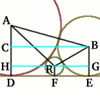Skip over navigation
Why do this problem?
The problem naturally brings in the formula for a circle and it could be used to introduce this formula.
The problem requires knowledge and understanding of the formula for the distance between two points, the use of Pythagoras Theorem and algebraic skills in solving simultaneous equations.
The problem introduces the concept of orthogonality which is very important in higher mathematics.
Possible approach
Depending on their experience of problem solving and thinking for themselves, if there is some lack of confidence then the class could first discuss how they are going to set about solving the problem. This should be in the context of the teacher making it explicit that the learners should be developing problem solving skills and growing out of dependence on the teacher to indicate methods to use.



Or search by topic
Number and algebra
Geometry and measure
Probability and statistics
Working mathematically
Advanced mathematics
For younger learners
Orthogonal Circle
Age 16 to 18
Challenge Level 





- Problem
- Getting Started
- Student Solutions
- Teachers' Resources
Why do this problem?
The problem naturally brings in the formula for a circle and it could be used to introduce this formula.
The problem requires knowledge and understanding of the formula for the distance between two points, the use of Pythagoras Theorem and algebraic skills in solving simultaneous equations.
The problem introduces the concept of orthogonality which is very important in higher mathematics.
Possible approach
Depending on their experience of problem solving and thinking for themselves, if there is some lack of confidence then the class could first discuss how they are going to set about solving the problem. This should be in the context of the teacher making it explicit that the learners should be developing problem solving skills and growing out of dependence on the teacher to indicate methods to use.
- List what information is given, what they are trying to find, and then how to use the information given.
- In trying to find the orthogonal circle the 3 unknowns are its radius and the coordinates of its centre.
- The diagram suggests the use of 3 right angled triangles and the use of Pythagoras' Theorem to give 3 equations.
- How can they solve the equations. How can they eliminate one of the variables between pairs of equations.
The learners can then work independently having planned how to work on the problem.
Key questions
What information is given in the question?
What are the unknowns? Have we assigned notation to refer to the unknowns?
Can we use the given information, and our mathematical knowledge, to write down some equations?
What methods have we used in the past to solve similar equations? Are those methods useful here?
You may also like
Baby Circle
A small circle fits between two touching circles so that all three circles touch each other and have a common tangent? What is the exact radius of the smallest circle?
Kissing
Two perpendicular lines are tangential to two identical circles that touch. What is the largest circle that can be placed in between the two lines and the two circles and how would you construct it?
Logosquares
Ten squares form regular rings either with adjacent or opposite vertices touching. Calculate the inner and outer radii of the rings that surround the squares.

